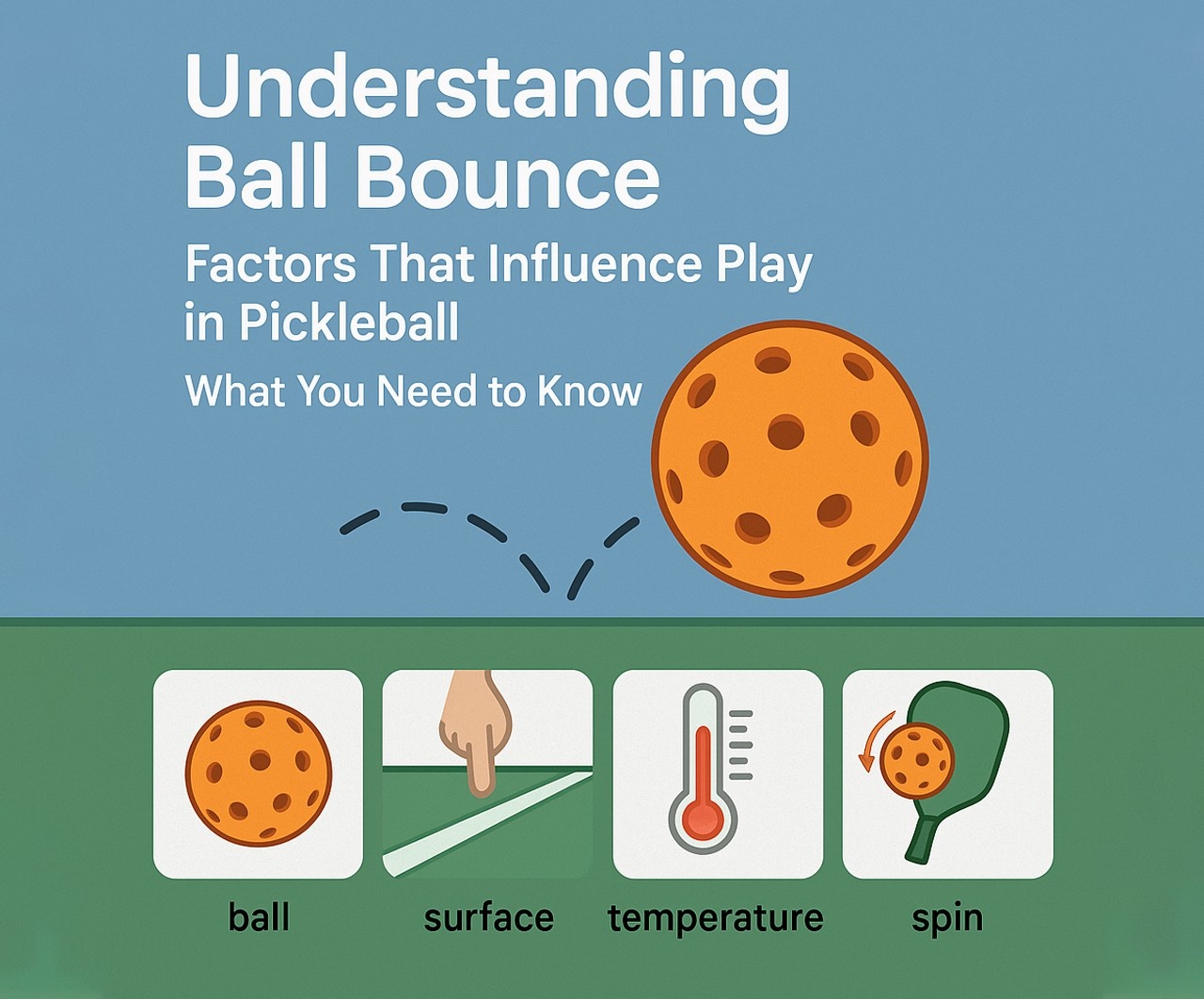In pickleball, ball bounce is an essential aspect of the game, influencing everything from strategy to player performance. Whether you’re setting up pickleball nets, using recess pickleball paddles, or buying used pickleball paddles, understanding how the ball bounces can dramatically improve your gameplay. The bounce of the ball is affected by several variables, including the paddle material, the court surface, and the weather conditions. Knowing how these elements work together will give you an edge on the court and help you make more informed decisions when choosing your equipment. In this article, we will break down the key factors that influence ball bounce in pickleball, providing you with a deeper understanding of the mechanics behind each shot. Know more..
The Science Behind Ball Bounce in Pickleball
To grasp how the ball bounces, it’s important to understand the basic physics of pickleball. The ball itself is made from a durable plastic material, often featuring holes to reduce air resistance. When the ball strikes the ground, it undergoes compression before rebounding upward. This rebound is heavily influenced by a variety of factors, such as paddle choice, court conditions, and atmospheric conditions. Let’s dive deeper into these factors and how they impact the game.
1. Type of Paddle: How It Affects Ball Bounce
The type of recess pickleball paddles you use has a direct impact on the ball’s bounce. Paddles come in different materials—composite, wood, and graphite—which can all affect how the ball interacts with the paddle surface and, consequently, the bounce.
- Wooden paddles: While more affordable, used pickleball paddles made of wood generally offer a less consistent bounce due to their heavier, less responsive nature.
- Graphite paddles: Graphite paddles, on the other hand, provide a cleaner, crisper hit that results in more predictable ball bounce. These paddles are often preferred by advanced players who want to have better control over their shots.
- Composite paddles: Composite paddles, which use a combination of materials like carbon fiber and fiberglass, offer a balance between power and control. They are designed to absorb the ball’s impact, which can result in a softer, more consistent bounce compared to wood.
The surface texture of the paddle also plays a role. Textured paddles create more friction, allowing players to put more spin on the ball, which can also influence how high the ball bounces after it hits the ground.
2. The Court Surface: A Crucial Factor for Bounce
The type of court surface is one of the most important factors affecting the ball’s bounce in pickleball. There are various types of court surfaces, each providing a unique bounce characteristic.
- Hard courts: Most standard pickleball courts are made from hard surfaces like asphalt or concrete. Balls tend to bounce higher and faster on hard courts due to the rigid nature of the surface. This means that if you’re playing on a hard court, you can expect faster gameplay and more aggressive shots.
- Indoor courts: Indoor pickleball courts, often made from wood or synthetic surfaces, tend to provide a lower bounce compared to hard courts. This results in a slower-paced game where precision and control are more important.
- Soft courts: Some outdoor pickleball courts are made from soft materials like clay or rubber. These surfaces absorb more of the ball’s energy, resulting in a lower and slower bounce. This type of surface is typically found on less common or specialized pickleball courts.
Each type of court will impact how the ball behaves. For example, playing on a soft court might require you to adjust your paddle technique and shot selection, while playing on a hard court might demand quicker reflexes and more power in your swings.
3. Weather Conditions and Their Effect on Bounce
The weather conditions also influence how the ball bounces in pickleball. Factors like humidity, temperature, and wind can all play a role in the way the ball interacts with the court.
- Temperature: Colder temperatures tend to make pickleball balls stiffer, which leads to a lower bounce. In contrast, warmer temperatures can make the ball softer, causing it to bounce higher and react more elastically when it hits the ground.
- Humidity: High humidity can cause the pickleball ball to absorb moisture, leading to a slightly heavier ball that may not bounce as high as usual. On the other hand, dry conditions will typically result in a ball that bounces higher and faster.
- Wind: Wind has the potential to drastically alter the trajectory of a pickleball shot. A strong headwind or tailwind can affect how the ball travels and the height of its bounce, making it more difficult to predict.
For players, understanding the weather’s impact on ball bounce is key to adapting your game strategy. If the weather is hot and dry, you might need to adjust your paddle grip or stroke to avoid overshooting the ball.
4. Ball Quality and Construction: A Vital Component of Bounce
The quality of the ball you’re using has a significant impact on bounce. In general, high-quality pickleball balls tend to offer more consistent and predictable bounces. The used pickleball paddles you play with may not affect the ball’s bounce as directly as the ball itself, but playing with an older or worn paddle can reduce control over the ball, which might make it harder to predict its bounce.
Pickleball balls come in two main types: indoor and outdoor balls. Indoor balls are softer and typically have fewer holes, which makes them bounce higher and more predictably. Outdoor balls, on the other hand, are heavier, made of harder plastic, and feature more holes to reduce wind resistance. These balls often have a lower, faster bounce, which requires more skill and precision to handle.
For consistent bounce during gameplay, always use the correct ball type for your environment, and avoid using old or cracked balls, as they will not perform well and may lead to an inconsistent bounce.
5. The Importance of Pickleball Nets in Bounce Dynamics
While pickleball nets may not directly affect the ball’s bounce, their placement and height do play a role in how the game is played. The standard net height in pickleball is 36 inches at the ends and 34 inches at the center. When the ball bounces, it must pass over the net, which means that any variation in net height can influence how high the ball needs to bounce for successful gameplay.
In addition, the tension of the pickleball nets can impact the way the ball interacts with it during play. A loosely strung net might cause the ball to deflect unpredictably, while a tighter net ensures that the ball’s bounce is influenced by the physics of the hit rather than the net’s instability.
6. Player Technique: How Your Stroke Affects Bounce
Finally, player technique and stroke mechanics have a significant effect on how the ball bounces. For instance, players who use a recess pickleball paddle with a good grip and proper stroke mechanics can manipulate the ball’s trajectory and bounce more effectively. The amount of spin you apply to the ball will alter its bounce characteristics.
- Topspin: A topspin shot causes the ball to dip down quickly and can result in a higher bounce after hitting the court.
- Backspin: A backspin shot tends to make the ball stay lower to the ground after it bounces, making it harder for your opponent to return.
The ability to control spin and stroke type allows players to manipulate the ball’s bounce, using it as a strategic advantage during play.
Conclusion
Ball bounce is a fundamental aspect of pickleball that influences strategy, gameplay, and overall player performance. Understanding how various factors such as pickleball nets, recess pickleball paddles, and used pickleball paddles affect the bounce of the ball is essential for both beginners and experienced players. By taking into account the court surface, weather conditions, ball quality, and your equipment choices, you can tailor your game to match the bounce dynamics of any situation.
Next time you’re on the court, remember that the bounce is not just an incidental aspect of the game—it’s a key element you can master with the right knowledge and techniques.

